
Mut, also known as Maut and Mout, was a mother goddess worshipped in ancient Egypt and the Kingdom of Kush in present-day North Sudan. In Meroitic, her name was pronounced mata): 𐦨𐦴. Her name means mother in the ancient Egyptian language. Mut had many different aspects and attributes that changed and evolved greatly over the thousands of years of ancient Egyptian culture.

Nefertari, also known as Nefertari Meritmut, was an Egyptian queen and the first of the Great Royal Wives of Ramesses the Great. She is one of the best known Egyptian queens, among such women as Cleopatra, Nefertiti, and Hatshepsut, and one of the most prominent not known or thought to have reigned in her own right. She was highly educated and able to both read and write hieroglyphs, a very rare skill at the time. She used these skills in her diplomatic work, corresponding with other prominent royals of the time. Her lavishly decorated tomb, QV66, is one of the largest and most spectacular in the Valley of the Queens. Ramesses also constructed a temple for her at Abu Simbel next to his colossal monument there.
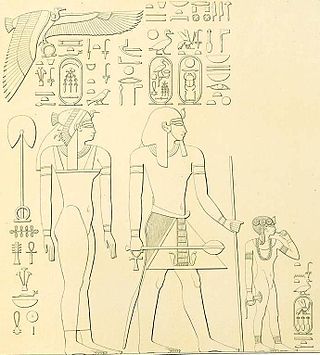
Ahmose was an Ancient Egyptian queen in the Eighteenth Dynasty. She was the Great Royal Wife of the dynasty's third pharaoh, Thutmose I, and the mother of the queen and pharaoh Hatshepsut. Her name means "Born of the Moon".
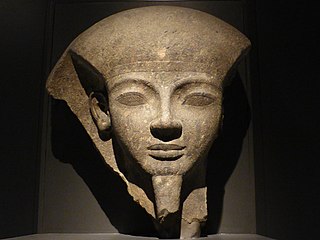
Ramesses VI Nebmaatre-Meryamun was the fifth ruler of the Twentieth Dynasty of Egypt. He reigned for about eight years in the mid-to-late 12th century BC and was a son of Ramesses III and queen Iset Ta-Hemdjert. As a prince, he was known as Ramesses Amunherkhepeshef and held the titles of royal scribe and cavalry general. He was succeeded by his son, Ramesses VII Itamun, whom he had fathered with queen Nubkhesbed.
The Divine Adoratrice of Amun was a second title – after God's Wife of Amun – created for the chief priestess of the ancient Egyptian deity Amun. During the first millennium BCE, when the holder of this office exercised her largest measure of influence, her position was an important appointment facilitating the transfer of power from one pharaoh to the next, when his daughter was adopted to fill it by the incumbent office holder. The Divine Adoratrice ruled over the extensive temple duties and domains, controlling a significant part of the ancient Egyptian economy.
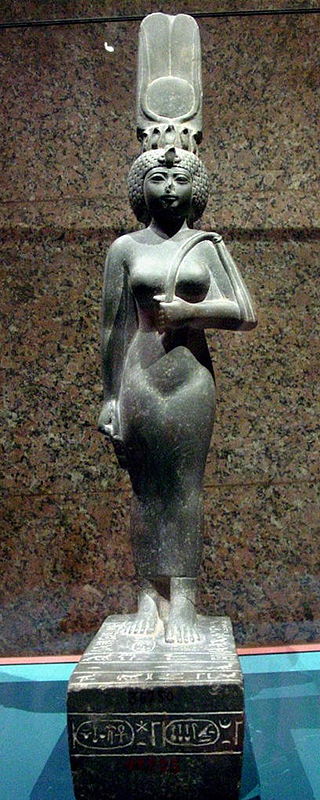
God's Wife of Amun was the highest-ranking priestess of the Amun cult, an important religious institution in ancient Egypt. The cult was centered in Thebes in Upper Egypt during the Twenty-fifth and Twenty-sixth dynasties. The office had political importance as well as religious, since the two were closely related in ancient Egypt.

Nitocris I served as the heir to, and then, as the Divine Adoratrice of Amun or God's Wife of Amun for a period of more than seventy years, between 655 BC and 585 BC.

Great Royal Wife, or alternatively, Chief King's Wife, is the title that was used to refer to the principal wife of the pharaoh of Ancient Egypt, who served many official functions.
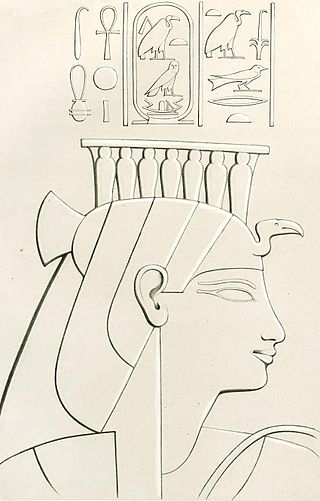
Mutemwiya was a minor wife of the Eighteenth Dynasty pharaoh Thutmose IV, and the mother of Pharaoh Amenhotep III. Mutemwiya's name means "Mut in the divine barque". While unconfirmed, it has been suggested that she acted as regent during the minority of her son Amenhotep III.
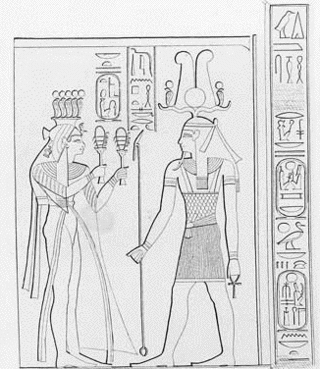
Iset Ta-Hemdjert or Isis Ta-Hemdjert, simply called Isis in her tomb, was an ancient Egyptian queen of the Twentieth Dynasty; the Great Royal Wife of Ramesses III and the Royal Mother of Ramesses VI.

The High Priest of Amun or First Prophet of Amun was the highest-ranking priest in the priesthood of the ancient Egyptian god Amun. The first high priests of Amun appear in the New Kingdom of Egypt, at the beginning of the Eighteenth Dynasty.

Duathathor-Henuttawy, Henuttawy or Henttawy("Adorer of Hathor; Mistress of the Two Lands") was an ancient Egyptian princess and later queen.
Nubkhesbed was an ancient Egyptian queen of the 20th Dynasty. She was the Great Royal Wife of Pharaoh Ramesses VI and mother of Pharaoh Ramesses VII, Princess Iset and Princes Amenherkhepshef and Panebenkemyt.
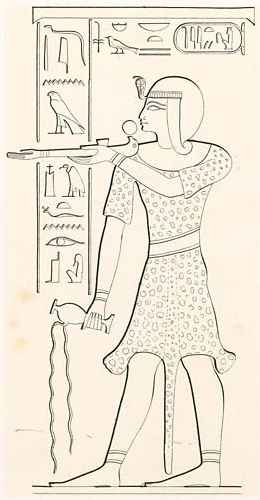
Tyti was an ancient Egyptian queen of the 20th Dynasty. A wife and sister of Ramesses III and possibly the mother of Ramesses IV.
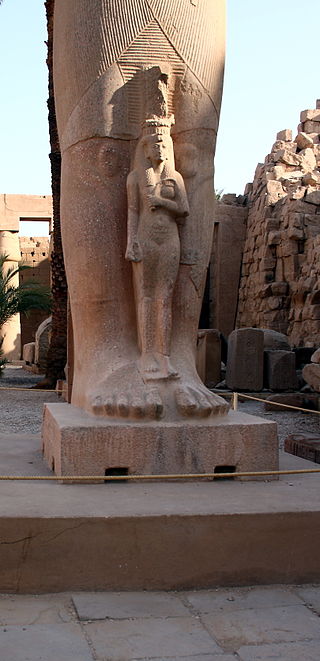
Maatkare(Mutemhat) was an ancient Egyptian high priestess, a God's Wife of Amun during the 21st Dynasty.
Mutnedjmet was an ancient Egyptian queen of the 21st Dynasty. She was the Great Royal Wife of her brother, Psusennes I.

The Eighteenth Dynasty of Egypt is classified as the first dynasty of the New Kingdom of Egypt, the era in which ancient Egypt achieved the peak of its power. The Eighteenth Dynasty spanned the period from 1550/1549 to 1292 BC. This dynasty is also known as the Thutmosid Dynasty for the four pharaohs named Thutmose.

The Twentieth Dynasty of Egypt is the third and last dynasty of the Ancient Egyptian New Kingdom period, lasting from 1189 BC to 1077 BC. The 19th and 20th Dynasties furthermore together constitute an era known as the Ramesside period. This dynasty is generally considered to be the start of the decline of Ancient Egypt.

Women in ancient Egypt had some special rights other women did not have in other comparable societies. They could own property and were, at court, legally equal to men. However, Ancient Egypt was a patriarchal society dominated by men. Only a few women are known to have important positions in administration, though there were female rulers and even female pharaohs. Women at the royal court gained their positions by relationship to male kings.
















